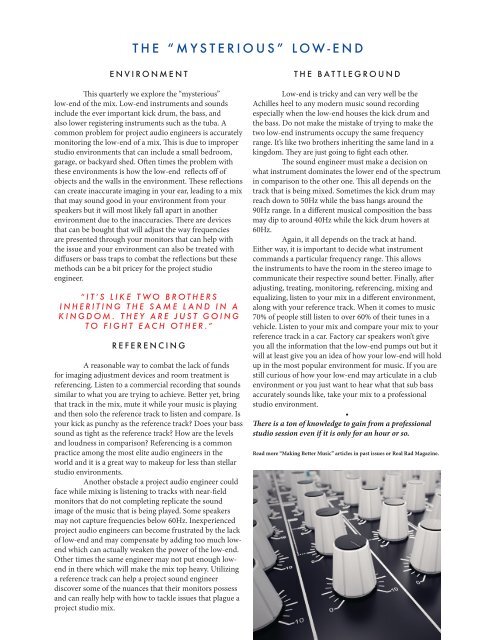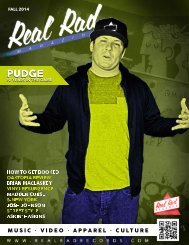Real Rad Magazine : Winter 2016
A 100% independant magazine featuring articles about music, art and culture. Visit www.RealRadRecords.com for more.
A 100% independant magazine featuring articles about music, art and culture. Visit www.RealRadRecords.com for more.
You also want an ePaper? Increase the reach of your titles
YUMPU automatically turns print PDFs into web optimized ePapers that Google loves.
THE “MYSTERIOUS” LOW-END<br />
ENVIRONMENT<br />
This quarterly we explore the “mysterious”<br />
low-end of the mix. Low -end instruments and sounds<br />
include the ever important kick drum, the bass, and<br />
also lower registering instruments such as the tuba. A<br />
common problem for project audio engineers is accurately<br />
monitoring the low-end of a mix. This is due to improper<br />
studio environments that can include a small bedroom,<br />
garage, or backyard shed. Often times the problem with<br />
these environments is how the low-end reflects off of<br />
objects and the walls in the environment. These reflections<br />
can create inaccurate imaging in your ear, leading to a mix<br />
that may sound good in your environment from your<br />
speakers but it will most likely fall apart in another<br />
environment due to the inaccuracies. There are devices<br />
that can be bought that will adjust the way frequencies<br />
are presented through your monitors that can help with<br />
the issue and your environment can also be treated with<br />
diffusers or bass traps to combat the reflections but these<br />
methods can be a bit pricey for the project studio<br />
engineer.<br />
“IT’S LIKE TWO BROTHERS<br />
INHERITING THE SAME LAND IN A<br />
KINGDOM. THEY ARE JUST GOING<br />
TO FIGHT EACH OTHER.”<br />
REFERENCING<br />
A reasonable way to combat the lack of funds<br />
for imaging adjustment devices and room treatment is<br />
referencing. Listen to a commercial recording that sounds<br />
similar to what you are trying to achieve. Better yet, bring<br />
that track in the mix, mute it while your music is playing<br />
and then solo the reference track to listen and compare. Is<br />
your kick as punchy as the reference track? Does your bass<br />
sound as tight as the reference track? How are the levels<br />
and loudness in comparison? Referencing is a common<br />
practice among the most elite audio engineers in the<br />
world and it is a great way to make up for less than stellar<br />
studio environments.<br />
Another obstacle a project audio engineer could<br />
face while mixing is listening to tracks with near-field<br />
monitors that do not completing replicate the sound<br />
image of the music that is being played. Some speakers<br />
may not capture frequencies below 60Hz. Inexperienced<br />
project audio engineers can become frustrated by the lack<br />
of low-end and may compensate by adding too much lowend<br />
which can actually weaken the power of the low-end.<br />
Other times the same engineer may not put enough lowend<br />
in there which will make the mix top heavy. Utilizing<br />
a reference track can help a project sound engineer<br />
discover some of the nuances that their monitors possess<br />
and can really help with how to tackle issues that plague a<br />
project studio mix.<br />
THE BATTLEGROUND<br />
Low-end is tricky and can very well be the<br />
Achilles heel to any modern music sound recording<br />
especially when the low-end houses the kick drum and<br />
the bass. Do not make the mistake of trying to make the<br />
two low-end instruments occupy the same frequency<br />
range. It’s like two brothers inheriting the same land in a<br />
kingdom. They are just going to fight each other.<br />
The sound engineer must make a decision on<br />
what instrument dominates the lower end of the spectrum<br />
in comparison to the other one. This all depends on the<br />
track that is being mixed. Sometimes the kick drum may<br />
reach down to 50Hz while the bass hangs around the<br />
90Hz range. In a different musical composition the bass<br />
may dip to around 40Hz while the kick drum hovers at<br />
60Hz.<br />
Again, it all depends on the track at hand.<br />
Either way, it is important to decide what instrument<br />
commands a particular frequency range. This allows<br />
the instruments to have the room in the stereo image to<br />
communicate their respective sound better. Finally, after<br />
adjusting, treating, monitoring, referencing, mixing and<br />
equalizing, listen to your mix in a different environment,<br />
along with your reference track. When it comes to music<br />
70% of people still listen to over 60% of their tunes in a<br />
vehicle. Listen to your mix and compare your mix to your<br />
reference track in a car. Factory car speakers won’t give<br />
you all the information that the low-end pumps out but it<br />
will at least give you an idea of how your low-end will hold<br />
up in the most popular environment for music. If you are<br />
still curious of how your low-end may articulate in a club<br />
environment or you just want to hear what that sub bass<br />
accurately sounds like, take your mix to a professional<br />
studio environment.<br />
•<br />
There is a ton of knowledge to gain from a professional<br />
studio session even if it is only for an hour or so.<br />
Read more “Making Better Music” articles in past issues or <strong>Real</strong> <strong>Rad</strong> <strong>Magazine</strong>.









